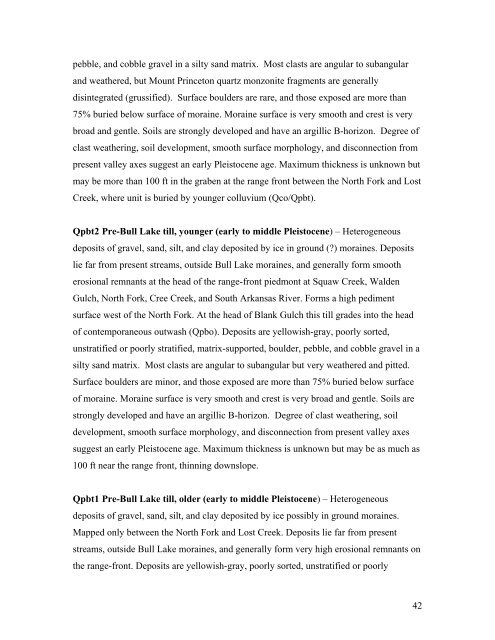Geologic Map of the Maysville Quadrangle, Chaffee County, Colorado
Geologic Map of the Maysville Quadrangle, Chaffee County, Colorado
Geologic Map of the Maysville Quadrangle, Chaffee County, Colorado
Create successful ePaper yourself
Turn your PDF publications into a flip-book with our unique Google optimized e-Paper software.
pebble, and cobble gravel in a silty sand matrix. Most clasts are angular to subangular<br />
and wea<strong>the</strong>red, but Mount Princeton quartz monzonite fragments are generally<br />
disintegrated (grussified). Surface boulders are rare, and those exposed are more than<br />
75% buried below surface <strong>of</strong> moraine. Moraine surface is very smooth and crest is very<br />
broad and gentle. Soils are strongly developed and have an argillic B-horizon. Degree <strong>of</strong><br />
clast wea<strong>the</strong>ring, soil development, smooth surface morphology, and disconnection from<br />
present valley axes suggest an early Pleistocene age. Maximum thickness is unknown but<br />
may be more than 100 ft in <strong>the</strong> graben at <strong>the</strong> range front between <strong>the</strong> North Fork and Lost<br />
Creek, where unit is buried by younger colluvium (Qco/Qpbt).<br />
Qpbt2 Pre-Bull Lake till, younger (early to middle Pleistocene) – Heterogeneous<br />
deposits <strong>of</strong> gravel, sand, silt, and clay deposited by ice in ground () moraines. Deposits<br />
lie far from present streams, outside Bull Lake moraines, and generally form smooth<br />
erosional remnants at <strong>the</strong> head <strong>of</strong> <strong>the</strong> range-front piedmont at Squaw Creek, Walden<br />
Gulch, North Fork, Cree Creek, and South Arkansas River. Forms a high pediment<br />
surface west <strong>of</strong> <strong>the</strong> North Fork. At <strong>the</strong> head <strong>of</strong> Blank Gulch this till grades into <strong>the</strong> head<br />
<strong>of</strong> contemporaneous outwash (Qpbo). Deposits are yellowish-gray, poorly sorted,<br />
unstratified or poorly stratified, matrix-supported, boulder, pebble, and cobble gravel in a<br />
silty sand matrix. Most clasts are angular to subangular but very wea<strong>the</strong>red and pitted.<br />
Surface boulders are minor, and those exposed are more than 75% buried below surface<br />
<strong>of</strong> moraine. Moraine surface is very smooth and crest is very broad and gentle. Soils are<br />
strongly developed and have an argillic B-horizon. Degree <strong>of</strong> clast wea<strong>the</strong>ring, soil<br />
development, smooth surface morphology, and disconnection from present valley axes<br />
suggest an early Pleistocene age. Maximum thickness is unknown but may be as much as<br />
100 ft near <strong>the</strong> range front, thinning downslope.<br />
Qpbt1 Pre-Bull Lake till, older (early to middle Pleistocene) – Heterogeneous<br />
deposits <strong>of</strong> gravel, sand, silt, and clay deposited by ice possibly in ground moraines.<br />
<strong>Map</strong>ped only between <strong>the</strong> North Fork and Lost Creek. Deposits lie far from present<br />
streams, outside Bull Lake moraines, and generally form very high erosional remnants on<br />
<strong>the</strong> range-front. Deposits are yellowish-gray, poorly sorted, unstratified or poorly<br />
42




